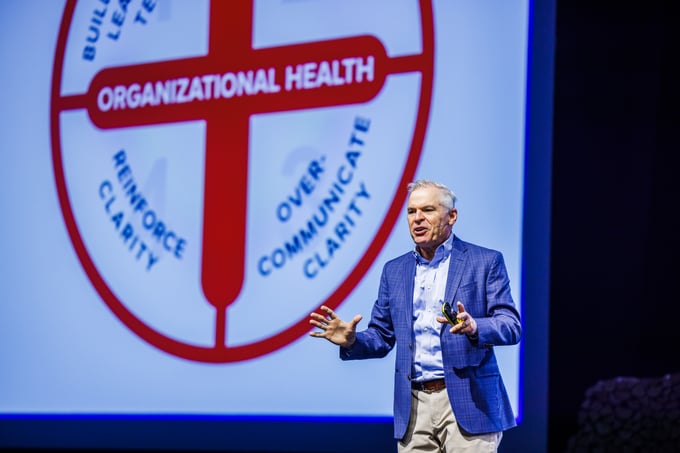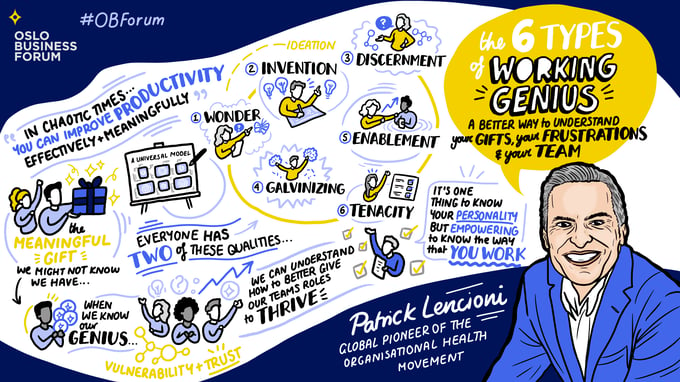Patrick has come up with a revolutionary new framework for teams. His most recent book, The Six Types of Working Genius, is designed to help people find joy and energy in their work.
Patrick Lencioni revealed to leaders the single most important thing they can do in chaotic times: discover your working genius.
“For almost no money, this will increase engagement, morale, motivation, and productivity,” he said. “It will deliver the most transformation in the shortest period of time.”
Leveraging people’s strengths—their working geniuses—allows businesses to do more with the people they have. In a chaotic and uncertain world, this changes everything.
A Framework by Accident
Patrick and his team didn’t set out to revolutionize the way we think about work by developing a new model. Rather, the framework came about by accident.
“Three years ago, my small company went back to work pretty quickly,” he said. “I was doing all kinds of Zoom calls, and I went from excited to bummed out to excited in about 15 minutes.”
One of his team members asked, “Why do you do that?” This simple question prompted them to explore why we like some parts of work and not others. They discovered that six activities must be done in any project, no matter the scope, size, or industry. They coined these six activities as “working geniuses.”
The 6 Types of Working Genius
Patrick believes we each have unique geniuses. When we identify which geniuses we are gifted with, we can begin doing more of the things that bring us joy and energy and less of the things that don’t. And beyond that, we can drive the ideation, activation, and implementation that improves business performance.
“We have amazing gifts we’re meant to use and understand, and many of us don’t even know we have them.”
Patrick’s Working Genius framework can help leaders uncover and tap into their own and their team members’ individual gifts.
Genius #1: Wonder
Wonder is the ability to look at things and ask questions. It is where every new idea starts.
Genius #2: Invention
Invention is the gift of hearing a question and wanting to come up with a solution. It is the ability to create new ideas from nothing.
Genius #3: Discernment
Discernment is good judgment, or a sense of what works and what doesn’t. It is the ability to look at something, understand it, and evaluate it.
Genius #4: Galvanizing
People with the gift of galvanizing love to inspire and encourage others. These people are cheerleaders who can mobilize people and get them moving in the right direction.
Genius #5: Enablement
Enablement is a desire to help. Someone with the gift of enablement can empower a team to get an idea or initiative off the ground.
Genius #6: Tenacity
People with the gift of tenacity love to get things done. They push to meet ambitious goals and blow through obstacles.
 Patrick Lencioni is an author and founder of The Table Group, a firm dedicated to promoting personal development and human dignity in the world of work. For 25 years, Patrick and his team have provided organizations with ideas, products, and services that improve teamwork, clarity, and employee engagement.
Patrick Lencioni is an author and founder of The Table Group, a firm dedicated to promoting personal development and human dignity in the world of work. For 25 years, Patrick and his team have provided organizations with ideas, products, and services that improve teamwork, clarity, and employee engagement.
Ideation, Activation, and Implementation
Patrick believes it’s fascinating to see how these geniuses work—independently and together. They are interdependent, and all six must be present on a team for the greatest chances of success.
Geniuses 1 and 2, Wonder and Invention, represent ideation. The people on your team who have these gifts are the origin of new ideas.
Geniuses 3 and 4, Discernment and Galvanizing, represent activation. They take things from idea to action.
Geniuses 5 and 6, Enablement and Tenacity, represent implementation. They help the process come full circle to completion.
Beyond this, Wonder, Discernment, and Enablement are responsive geniuses. People with these gifts respond to others, receiving questions or ideas and doing something with them. Invention, Galvanizing, and Tenacity are disruptive geniuses (“In a good way!” Patrick said.) People with these gifts bring about change.
Doing Away with Judgement
While each working genius is important, no one is good at all of them. Patrick and his team discovered that most people can categorize the six geniuses in three ways:
1. Your working genius is your greatest ability. It gives you joy and energy.
2. Your working frustration is the task (or tasks) you hate doing. It deprives you of joy and energy.
3. Your working competency is the work you can do but not what you were meant to do. It falls between your working genius and your working frustration.
Patrick acknowledged that many people have difficulty admitting to their working geniuses, frustrations, and competencies. We often feel like we need to be good at everything, and acknowledging our weaknesses or vulnerabilities can bring on feelings of guilt or shame.
He demonstrated this with a personal example. “Out of college, I got the best job in America at Bain & Company,” he said. “The whole job was the two things I hate most.”
For years, Patrick thought he was lazy or not smart enough because he failed at that job. He felt guilt and judgment. Decades later, he realized that he should have never taken the job because it didn’t align with his working geniuses.
“It’s a great thing when you stop feeling guilty about the stuff you don’t like,” he said.
Patrick explained that sharing your working genius, frustration, and competency with others is not an excuse for the things you don’t like to do. Rather, it is an explanation. He shared an example of a leader who used the Working Genius Framework before going into his performance review. He knew he was struggling in his current role. Instead of being reprimanded for his failures, he was moved into another job (and received a raise with it).
“No one wants to put you in a job that’s miserable for you,” Patrick said. “But they need to know what your working genius is.”
Build Your Team’s Map
Patrick reminded leaders that no one possesses every working genius. “No one can do it on their own because they literally don’t have all the skills,” he said. That’s the essence of teamwork and what makes this such a critical exercise for every team.
Similarly, he encouraged leaders to uncover someone’s working genius when making a hiring decision. “Hire them because they are a core value fit, but find out right away what their genius is and put them there,” he said.
He pressed leaders at Oslo Business Forum to get together with their teams, build a team map, and discover everyone’s genius. He said what you’ll discover is that “You don’t have to get rid of people or hire new people to see your productivity, morale, and engagement go up.”
Key Points
- The six working geniuses are: wonder, invention, discernment, galvanizing, enablement, and tenacity.
- The first two geniuses represent ideation, the second two represent activation, and the last two represent implementation.
- The Geniuses of Wonder, Discernment, and Enablement are responsive. They receive something from others and do something with it.
- The Geniuses of Invention, Galvanizing, and Tenacity are disruptive. They bring about change in a good way.
- Everyone has working geniuses, working frustrations, and working competencies.
- When leaders uncover their team’s working geniuses and share their own, they can increase engagement, morale, motivation, and productivity.
Questions to Consider
- What are your working geniuses? Frustrations? Competencies?
- Are the people on your team aware of your working genius? How might sharing your gifts improve the environment for everyone?
- Look at the people on your team. What are their working geniuses?
- How can you better align people’s tasks to their strengths? What might the outcome be?

Want to be a part of the OBF community? Join Oslo Business Forum 2024: Courageous Leadership now!
